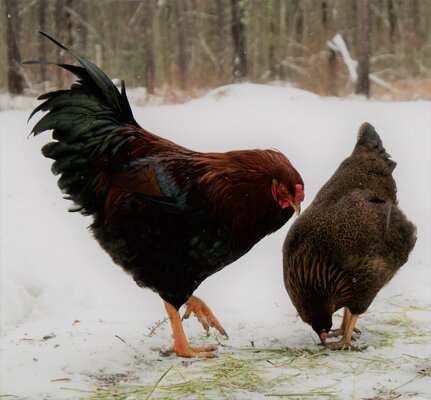I am starting a breeding project for a sustainable dual purpose breed that thrives on forage, goes broody and raises its own chicks, etc. In this area, it will need to be both cold and heat hardy and able to withstand some predator pressure.
The breeds I chose were Bielefelder (roo), Jersey Giant, Mottled Java, Black Australorp, and Rhode Island Red. Because of problems I ended up with a Bielefelder pullet, three Jersey Giants, one Mottled Java. The BA'S and RIR's are still babies.
Anyway, one of the JJ's ended up being a roo, and I got an adult Biel roo from another source. So I have enough for two population groups with the breeds I selected.
I want to keep the two groups separate, unrelated for the first few generations, but I'm concerned as to what to do with the Jersey Giants.
If I leave the Jersey Giant pullets with the Bielefelder roo, the population will be heavily weighted toward JJ in the selection phase (3rd gen) and I really don't want that.
1st possibility, get rid of the JJ roo and have the Bielefelder be the foundation. Stick with one group for now.
2nd, get rid of the JJ roo and get a roo from another breed for the breakout group. Dominique and Orpington have both been suggested.
3rd, create a third population and move selection back another generation.
All viable solutions, but they all have their problems as well.
Are there other options that I haven't thought of? Solutions or problems?
The current plan is
B x MJ and JJ
JJ x BA and RR
The next generation roo for the rotation to group 2 would have to be B x MJ to avoid the weighting toward JJ for one more generation.
The breeds I chose were Bielefelder (roo), Jersey Giant, Mottled Java, Black Australorp, and Rhode Island Red. Because of problems I ended up with a Bielefelder pullet, three Jersey Giants, one Mottled Java. The BA'S and RIR's are still babies.
Anyway, one of the JJ's ended up being a roo, and I got an adult Biel roo from another source. So I have enough for two population groups with the breeds I selected.
I want to keep the two groups separate, unrelated for the first few generations, but I'm concerned as to what to do with the Jersey Giants.
If I leave the Jersey Giant pullets with the Bielefelder roo, the population will be heavily weighted toward JJ in the selection phase (3rd gen) and I really don't want that.
1st possibility, get rid of the JJ roo and have the Bielefelder be the foundation. Stick with one group for now.
2nd, get rid of the JJ roo and get a roo from another breed for the breakout group. Dominique and Orpington have both been suggested.
3rd, create a third population and move selection back another generation.
All viable solutions, but they all have their problems as well.
Are there other options that I haven't thought of? Solutions or problems?
The current plan is
B x MJ and JJ
JJ x BA and RR
The next generation roo for the rotation to group 2 would have to be B x MJ to avoid the weighting toward JJ for one more generation.

